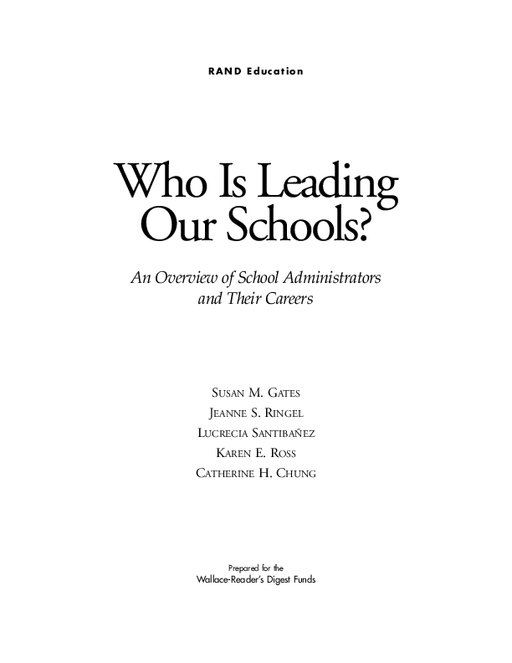- Author(s)
- Susan M. Gates, Jeanne S. Ringel, Lucrecia Santibanez, Karen E. Ross, and Catherine H. Chung
- Publisher(s)
- RAND Corporation
- DOI Link
- https://doi.org/10.7249/MR1679
Research Approach
RAND's study’s goal was to answer four key questions about the careers of school administrators:
- What are the characteristics of school administrators, and how have they changed over time?
- What kinds of movement into and out of the school administrative career field are occurring, and what factors are likely to affect these movements?
- What kinds of movement between the different types of positions within the administrative career path are occurring?
- What kinds of movement are occurring within the principalship, and what do they reveal about the relationship between position turnover and observable school characteristics?
The researchers began their study by developing a conceptual framework for understanding the careers of school administrators. They then used the framework to summarize what is currently known about school administrators and their careers and to address the four key questions listed above. Their summary draws on a broad review of the existing literature as well as their analyses of such career-related issues as salary, career paths, and attitudes using the National Center for Education Statistics (NCES) Schools and Staffing Survey (SASS) data from the U.S. Department of Education and the Current Population Survey (CPS) from the U.S. Census Bureau.
The Wallace-Readers Digest Funds LEADERS Count initiative focused on promoting the improvement of school leadership, broadly defined. This study focused more narrowly on understanding the careers of those who currently hold traditionally defined positions of responsibility and authority in primary and secondary schools (mainly principals and superintendents). While such individuals are an important aspect of school leadership, current discussions on ways to improve school leadership focus on the roles played by people throughout the school system (Resnick and 4 Who Is Leading Our Schools? Glennan, 2002) and on redefining the role of the principal and/or superintendent (Portin et al., 2003).
This research was directed at understanding what existing data and research can tell us about the individuals who hold formal positions of responsibility and authority, as currently defined, in schools. Thus, this study should be viewed as a complement to current research on the role of principals and the role of school leadership in education reform.
In press reports and policy debates, there is much discussion about the “shortage” of principals and school administrators. This study is related to and can inform a discussion of this shortage, but a complete analysis of a shortage must consider supply, demand, and the relationship between the two. By focusing on the careers of school administrators, RAND has analyzed the supply but not the demand.

